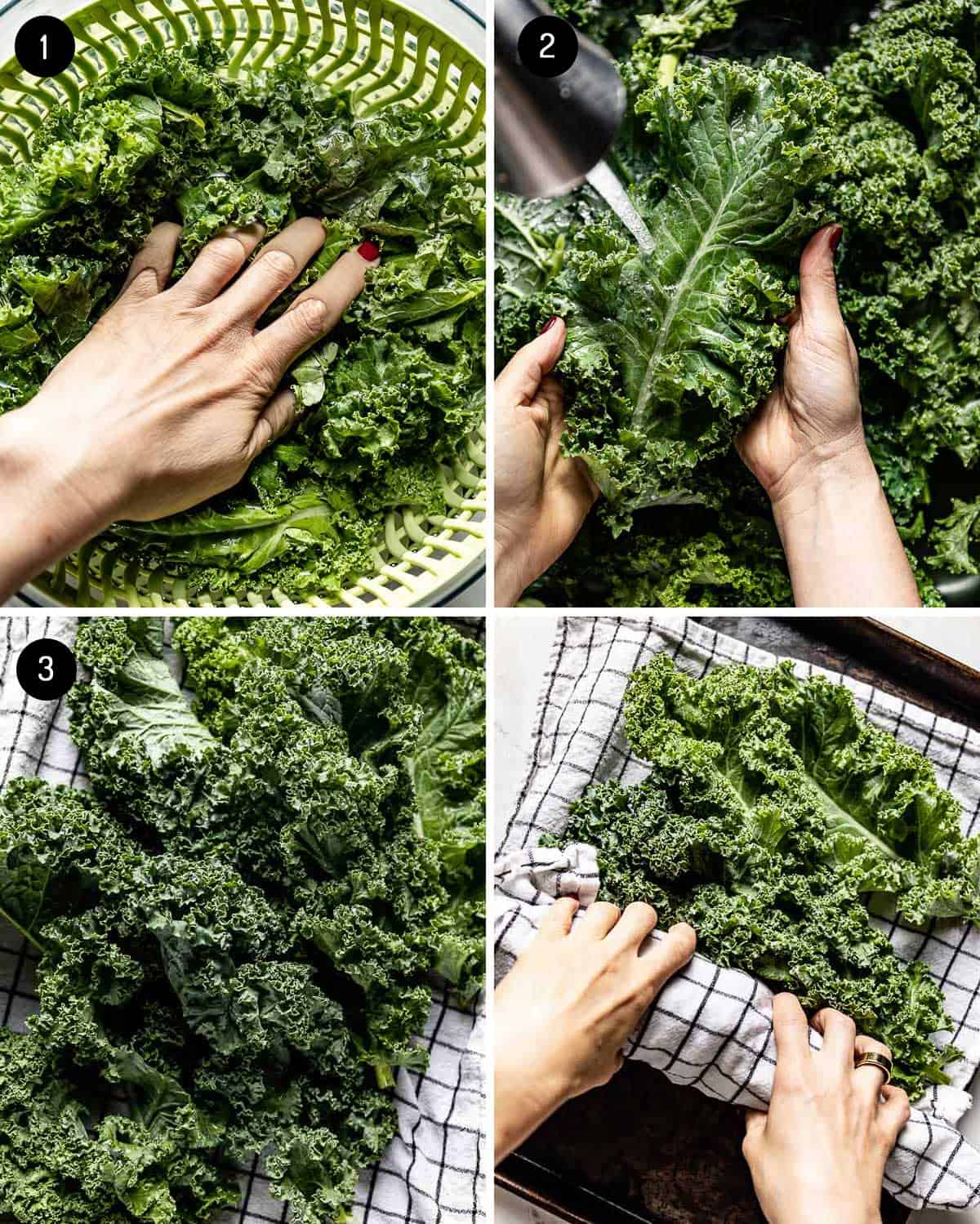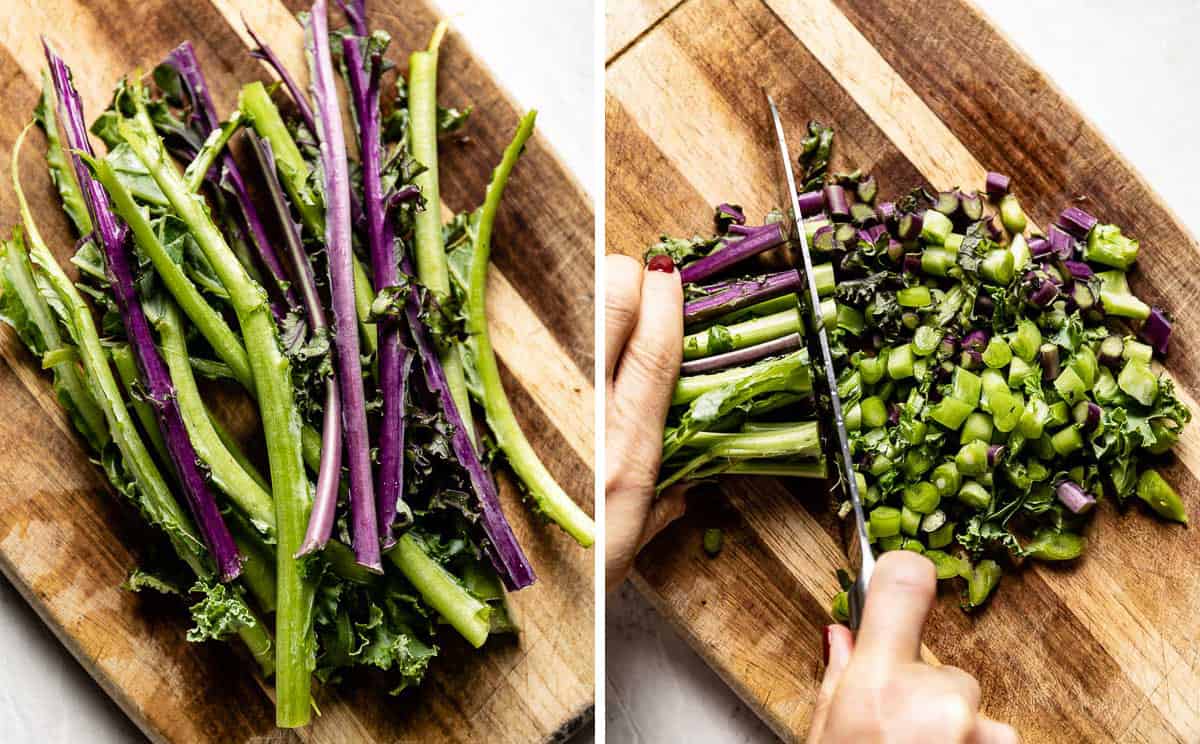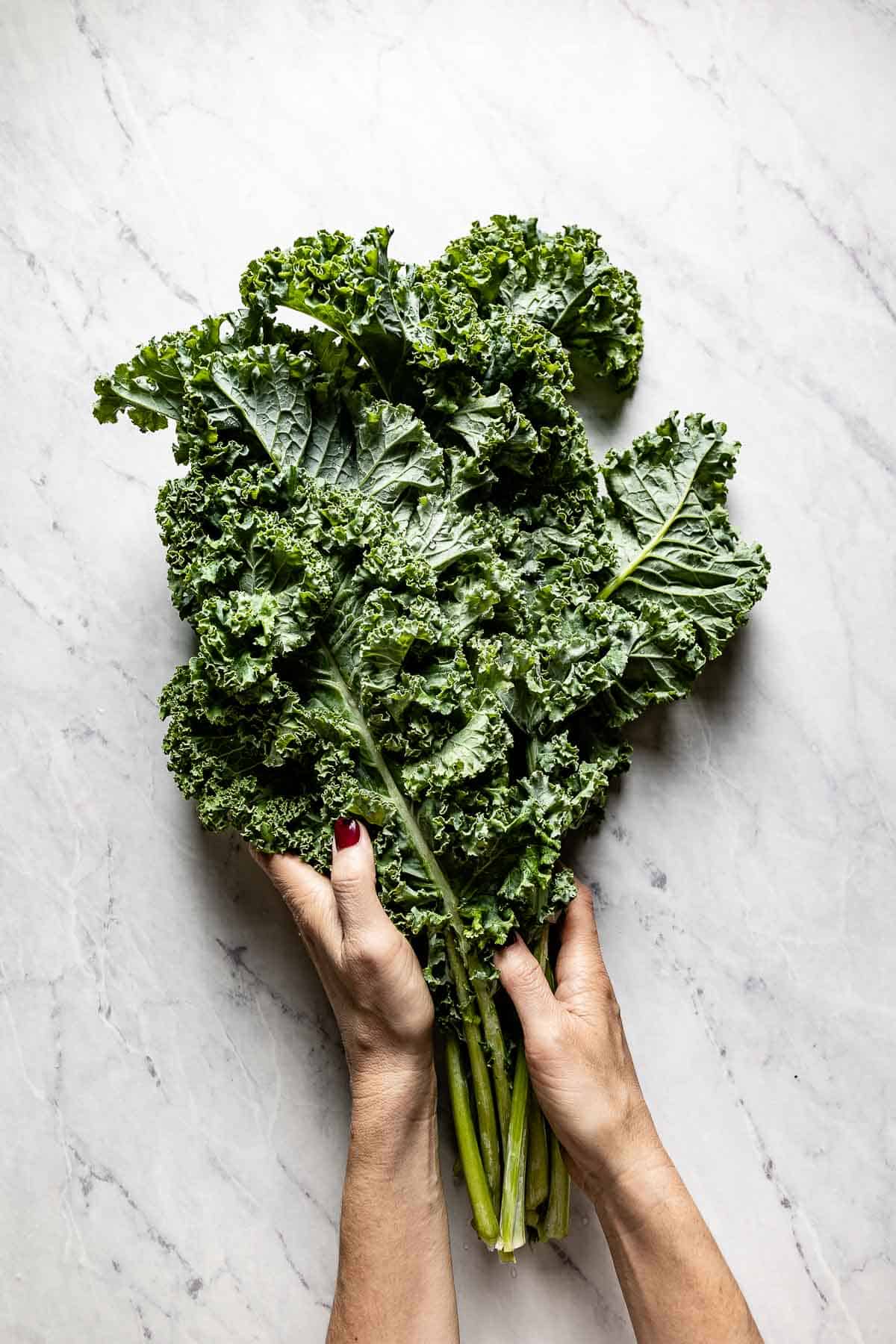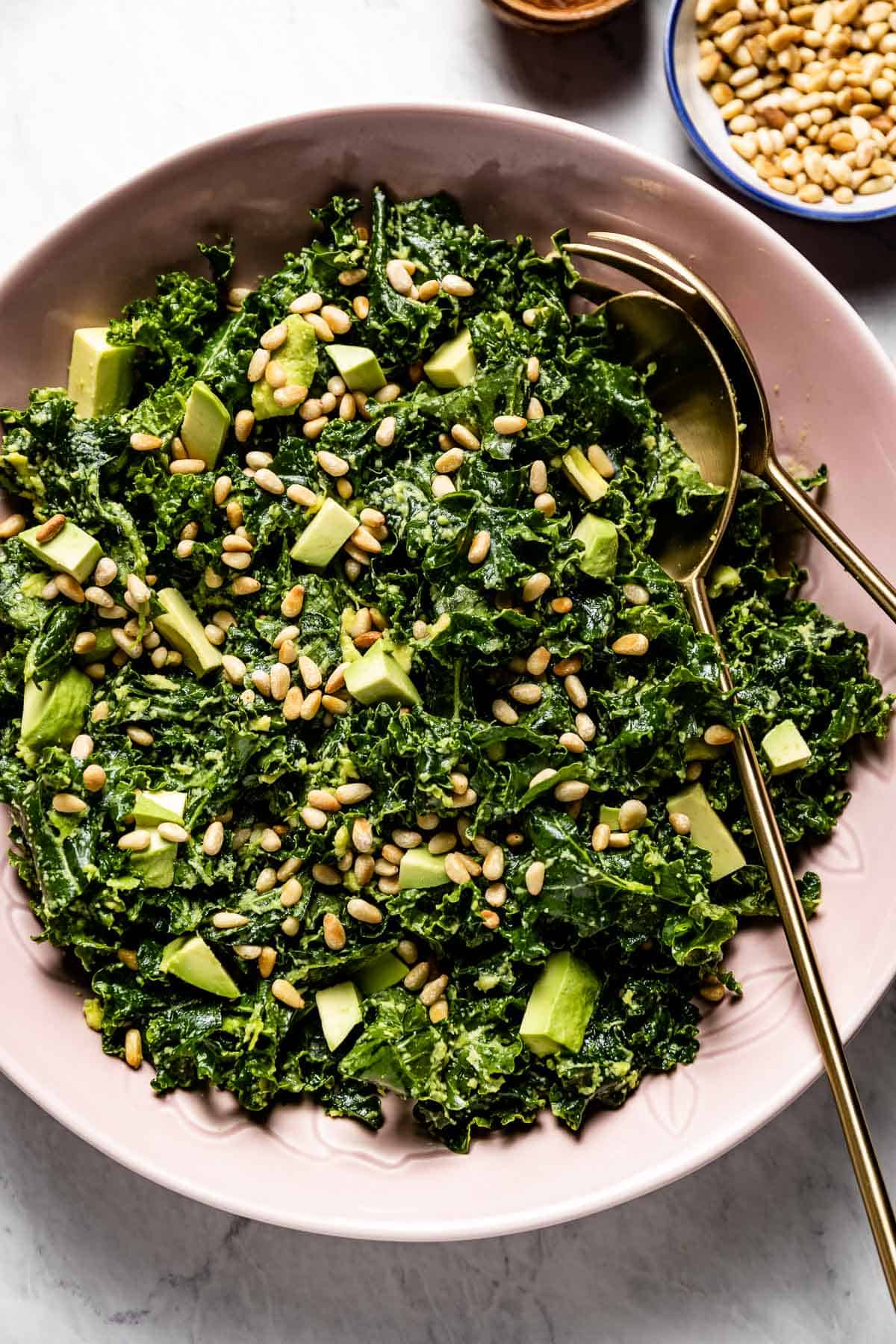Though there are many types of kale, my recipe for how to chop kale will work for the most common varieties of kale: curly kale, red Russian kale, and lacinato kale (AKA “dinosaur kale”). Kale varieties like baby kale have smaller leaves and require alternate cutting methods.

Wash & Dry Fresh Kale
Learning how to wash kale is an easy skill that takes seconds to complete. In three simple steps, you can rest assured that your kale is safe to eat.

- Submerge the kale: To clean kale greens, fill a large bowl (or your kitchen sink) with cold water. Then, add your kale to the bowl, being sure to submerge all of the leaves.
- Rinse the leaves: Rinse each leaf under cold water, removing as much debris as possible.
- Dry the kale: Line a baking sheet with a clean kitchen towel. Transfer the washed kale to the baking sheet, laying out the leaves so that each touches the towel beneath. Then, beginning at one end of the sheet, roll the towel into a cylinder with the kale inside to dry the leaves.
PRO TIP: To cut your drying time in half, the best way to clean fresh kale is to use a salad spinner (affiliate link) instead of a bowl and towel.
Remove Stems
When it comes to destemming kale, there are two main methods from which to choose:

- Hold and pull: Hold the base of a kale stem with one hand. Then, place your other hand around the stem, just above your first hand. Using your first hand, pull the stem downwards so that the leaves pass through the fist of your second hand and, in the process, detach from the stem.
- Fold and slice: Place a piece of kale on a cutting board. Fold its leaves in half so the stem lies at one end of the fold. Use a sharp knife to slice the leaves away from the stem in one swift movement.
How to Chop?
While cutting kale is a cinch, the correct way to slice kale depends on the recipe you want to make. In general, there are two main methods for how to cut kale:

- How to chop kale for a salad: I recommend using the chiffonade method to trim kale for salads. First, roll your kale leaf like a cigar and place it on a cutting board. Then, chop the tight cylinder into thin strips. You may also consider massaging kale before adding it to your salad.
- How to chop kale for soup & stews: If you plan to use your kale in a soup or stew, tear the kale leaves by hand into large, rough pieces. Then, add the pieces to your dish just before serving.
What to do with Chopped Kale?
Kale preparation is a godsend for quick, nutritious eats. Once you learn how to destem and cut kale properly, you’ll be astounded by how many flavor-packed dishes you can prepare.
Additionally, not only is this cruciferous vegetable packed with superfoods, but its bright green leaves also make a tasty addition to all your favorite kale recipes. Here are a few suggestions to get you started:
- Blanch: You don’t have to trek to the grocery store every time you prepare fresh kale for cooking. Blanch your kale after chopping it, store it in the fridge or freezer, and use it whenever you’re ready. It’s that easy! Plus, you can make meal prep a breeze with my foolproof methods for Blanched Kale and How to Store Kale.
- Make a green smoothie: Once you have your kale chopped, the options for nutritious pick-me-ups are endless. You can prepare some of my favorite kale recipes in less than five minutes, like a Pineapple Kale Smoothie and Green Turmeric Smoothie.
- Give it a massage & turn it into a salad: Cutting kale for salad is a no-brainer in vegetarian cooking. Follow my foolproof guide for How to Massage Kale, and you can whip up a kale chop as delicious as my Avocado Massaged Kale Salad, Brussels Sprouts Kale Salad, or Lemon Kale Caesar Salad.
- Add it to soups: Looking for an effortless way to add leafy greens to soup? Satisfy your tastebuds and get significant health benefits by adding sliced kale to a soup just before serving. Tuscan Kale Soup, Chicken Veggie Soup, and Vegetable Beef Soup are some of my favorites.
- Make kale chips: It is no secret that kale chips are a great snack. My go-to recipe is this Garlic Kale Chips.
What to do with Leftover Stems?
Anyone can learn how to remove kale stems like a pro. Now you can put the whole plant to work by incorporating leftover stems into recipes as genius as they are tasty.

- Blanch: If you don’t like to waste fresh produce, I have good news. Once blanched, the stalk of kale makes a good addition to smoothies and pesto recipes.
- Sautée or stir fry: Transform tough stems into veggie-packed side dishes by sautéeing or stir-frying them. It takes less than 15 minutes to prepare dishes as delectable as this Sweet and Spicy Kale Stems.
- Add into stock: One of my favorite ways to make the most of a kale harvest is to use the stems in DIY stock recipes. Simply add your kale ribs to recipes like my Homemade Chicken Stock for the best flavor.
Expert Tips
There’s no secret to prepping kale like a master chef. With these easy pointers, you’ll learn the best method for chopping kale—without any extra hassle!
- Take it out of the fridge right before you are ready to use it: Fresh kale leaves will start to soften and lose their freshness as soon as you take them out of the fridge. Therefore, keep them in the fridge until you are ready to cut them and use them in your recipe.
- Cut right before using: Similarly, because cut leaves rot faster than whole leaves, it’s a good idea to prepare fresh kale just before you use it. Chopping kale right before use will ensure your recipes turn out as fresh and crisp as possible.
- Use a good knife: The best kitchen tools are the sharpest when chopping kale plants. Be sure to use a sharp knife (affiliate link) as you learn how to cut kale for cooking.
FAQs
This simple FAQ has everything you need to be a kale connoisseur, from how to stem kale to making kale as palatable as possible. Healthy eating has never been so convenient!
To me, using your hands to pull kale leaves off their stem is the easiest way to cut kale. Simply place both hands on the base of a kale stem and use one hand to pull the stem through the fist of the other. Once destemmed, roll each leaf like a cigar and give it a chop in your desired thickness.
Though removing kale stems isn’t technically necessary, I recommend it. Kale ribs are tougher and more bitter than kale leaves, and they take more time to cook.
No, kale stems are perfectly safe to eat. In fact, I recommend saving leftover kale stems to use in smoothies, pesto recipes, stir-frys, and even chicken stock.
According to Sharon Hanna’s book, “The Book On Kale” (affiliate link), you should cut kale right before you are ready to use it in your cooking for the best flavors and most retained nutrients. To harvest kale, just cut off the leaves (or snap them off in a downward motion) for your desired recipe but leave the plant for growing.
More Helpful Kale Articles
Can’t get enough hearty greens? Then I have great news for you: With my collection of foolproof kale guides, even beginner chefs can become an expert in all things “kale.”
- 7 Different Varieties of Kale: Feel confused when you go to the store? Not sure which type of kale is for your recipe? Be sure to check out my guide to learn about the different varieties of kale.
- How to Store Kale: If you love preparing kale in bulk, then proper kale storage is just what you need. Learn how to store kale in the fridge and the freezer while keeping it as fresh as possible.
- How to Blanch Kale: If you want to take the stress out of meal prep, blanching kale is a must. In five minutes, you can tenderize your kale and make it fridge- and freezer-safe.
- How to Massage Kale: Learn how to tenderize kale’s tough leaves and eliminate bitter flavor with just three simple ingredients. Massaging kale is the perfect way to prepare your leafy green for salads, slaws, and more.
If you find this guide on How To Cut Kale or any one of our other How-To Guides on Foolproof Living helpful, please take a minute to leave a rating and a review. Doing so helps others who are planning to follow the processes outlined in this post.

How to Cut Kale
Ingredients
- 1 bunch Kale
Instructions
- Wash and rinse kale leaves: Place large kale leaves in a large bowl (or the kitchen sink) filled with water making sure that the kale leaves are fully submerged in water. Rinse each leaf under cold running water.
- Dry kale leaves: Line a baking sheet with a kitchen towel and transfer the washed kale so that each leaf touches the towel underneath. Then, beginning at one end of the sheet, roll the towel into a cylinder with the kale inside to dry the leaves. Alternatively, if you have one, you can use a salad spinner to dry the kale.
- Remove the stems: Hold the base of a kale stem with one hand and place your other hand around the stem, just above your first hand. Using your first hand, pull the stem downwards so that the leaves pass through the fist of your second hand and, in the process, detach from the stem. Or, you can place a piece of kale on a cutting board. Fold its leaves in half, so the stem lies at one end of the fold. Use a sharp pairing knife to slice the leaves away from the stem in one swift movement.
- Chop Kale: Place a large kale leaf on a cutting board and roll it up like a cigar. Chop it into thin strips using a sharp knife. If you are using it for salads, cut it into thin strips. For soups and stews, chop it in large chunks.*
- If necessary, rotate and chop in the other direction to make even more slices. Repeat the same process with the rest of the kale leaves.
Notes
- *Alternatively, you can tear the large leaves by hand into small pieces.
- Take kale out of the fridge and cut right before you are ready to use it in your recipe: Kale leaves start to soften as soon as you take them out of the fridge, so I recommend keeping it in the fridge until you are ready to use it in your recipes.
Nutrition
Nutrition information is automatically calculated, so should only be used as an approximation.














